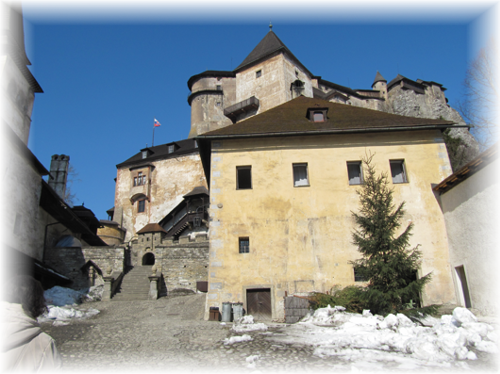

History of Orava Castle
Orava Castle was built on a limestone rock above Orava river. It was built to protect merchants´route connecting Austria-Hungary with Poland, to protect the borders with Poland and it was an administrative center, too. First historical mentions about Orava Castle are dated in 1267. At that time, the castle occupied only a small area and consisted of only few buildings built of stones. However, the fortified area was almost as large as the area of the nowadays castle with its vertical arrangement into the Upper, Middle and Lower Castle. Buildings of the Upper Castle had only their ground floor built of stone, while the upper part was constructed of wooden logs. There were no doors or windows in the lower part. People walked into the tower by climbing portable stairs leading to the second floor. In the second half of 13th century, the Middle Castle consisted only of a four-storied tower and the Middle Castle buildings belonged to the outer bailey. The first official owner was Balassa, who donated the castle to King Bella IV. Bella did not live in the castle himself, so the government was in the hands of castellans. Later on, there were many owners (Matúš Čak Trenčianský, Magister Dončo, king Karel Robert and many more). One of the most significant owners was Peter Komorovský, who was a castellan first, and later he got the castle as royal donation. He devoted much attention to the castle´s defence systems, especially replacing wooden constructions by stone and masonry. In 15th century, Jan Jiskra and his warriors unsuccessfully attempted to conquer the castle.
In 1474, King Matyáš Hunyady-Corvinus became the new owner of the castle. He improved the security of the castle (and also the state borders). Erection of a palace within the Middle castle meant adding several rooms to the existing ones. Next significant building improvements were done by Jan of Dubrovec in 16th century. Afterwards, the castle was owned by Turzo family, one of the richest and most important families of Slovakia at that time. The family had the castle re-build re-fortify and wooden roofs were replaced by stone masonry.
In 17th century, the whole region was full of unrests due to anti-Habsburg rebellions. The region was plundered and many people escaped to safer places. In 1672, the castle was captured by serfs leaded by Gašpar Pika. However, the rebellion was unsuccessful, Gaspar Pika was executed as well as 24 village mayors.
In 1709, the castle was captured and significantly damaged during Rákóczi´s rebellions. Some parts were repaired, however, in 1800 almost the whole castle was destroyed in a fire, after which it remained deserted for 60 years. In 1861, under the governorate of Jozef Pálfy, a new reconstruction started. In 1861, the first museum was opened there. In 1950´s, the castle was rebuilt for the purpose of the Natural History museum. Nowadays, the castle is opened for public and there are three collections – Ethnographic, History and Natural collections. Visitors are welcomed to take a guided tour in the castle.
 Orava castle 2 01 |
 Orava castle 2 02 |
 Orava castle 2 03 |
 Orava castle 2 04 |
 Orava castle 2 05 |
 Orava castle 2 06 |
Back


